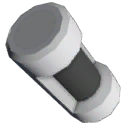Difference between revisions of "Kit (Cable Fuses)"
From Unofficial Stationeers Wiki
F1r3w4rr10r (talk | contribs) (Update to use the new Structurebox syntax) |
(clarified benefit of the fuse with an example) |
||
| (One intermediate revision by one other user not shown) | |||
| Line 18: | Line 18: | ||
==Description== | ==Description== | ||
| − | Fuses comes in four variants (1kW, 5kW, 50kW, 100kW) and are mounted | + | Fuses comes in four variants (1kW, 5kW, 50kW, 100kW) and are mounted on top of cables. The fuse breaks when power flowing through it exceeds its rating. It is useful to place fuses as close to the power intake of a power grid as possible as when overwhelming power enters the grid, only the fuse will break instead of random cables throughout the entire grid. |
For reference, [[Cable Coil|Normal cables]] break at 5kW and [[Cable Coil (Heavy)|Heavy cables]] break at 100kW. | For reference, [[Cable Coil|Normal cables]] break at 5kW and [[Cable Coil (Heavy)|Heavy cables]] break at 100kW. | ||
| + | |||
| + | The benefit of the fuse is that it gives you control over WHERE your electric grid will break in case of an overload. You have to take care though that you have fuses on all possible paths between producers and consumers, otherwise segments that don't have fuses will again break at random places. For example, imagine you have a "Y"-constellation of cabling with an electricity producer at the base (bottom) of the "Y"-branch and consumers at the end (top) of the two "Y"-branches. If you would place a fuse on only one of the branches (between the split and the consumer), that fuse would burn out and in addition the cable would break at one additional place, because after the fuse breaks there is still an active "path" from the producer to the other consumer. But if you would place the fuse between the producer and the split, then only the fuse would burn out, because after that the path to all consumers is disconnected. | ||
</translate> | </translate> | ||
Latest revision as of 09:07, 3 February 2020
 | |
| Constructing Options | Cable Fuses |
|---|---|
| Properties | |
| Stacks | Yes (10) |
| Recipe | |
| Created With | Electronics Printer |
| Cost | 5g Iron, 5g Copper |
| Operation | |
|---|---|
| Construction | |
| Placed with | Kit (Cable Fuses) |
| Placed on | Small Grid |
| Stage 1 | |
| Deconstruction | |
| Deconstructed with | Screwdriver |
| Item received | Kit (Cable Fuses) |
Description[edit]
Fuses comes in four variants (1kW, 5kW, 50kW, 100kW) and are mounted on top of cables. The fuse breaks when power flowing through it exceeds its rating. It is useful to place fuses as close to the power intake of a power grid as possible as when overwhelming power enters the grid, only the fuse will break instead of random cables throughout the entire grid.
For reference, Normal cables break at 5kW and Heavy cables break at 100kW.
The benefit of the fuse is that it gives you control over WHERE your electric grid will break in case of an overload. You have to take care though that you have fuses on all possible paths between producers and consumers, otherwise segments that don't have fuses will again break at random places. For example, imagine you have a "Y"-constellation of cabling with an electricity producer at the base (bottom) of the "Y"-branch and consumers at the end (top) of the two "Y"-branches. If you would place a fuse on only one of the branches (between the split and the consumer), that fuse would burn out and in addition the cable would break at one additional place, because after the fuse breaks there is still an active "path" from the producer to the other consumer. But if you would place the fuse between the producer and the split, then only the fuse would burn out, because after that the path to all consumers is disconnected.
